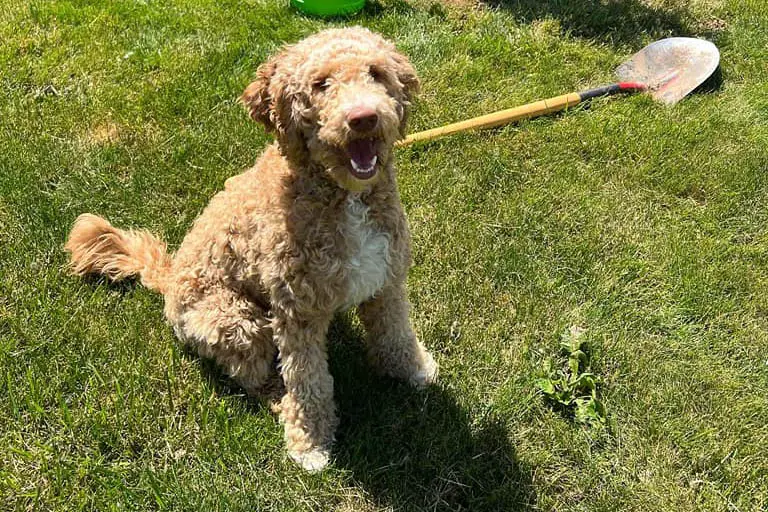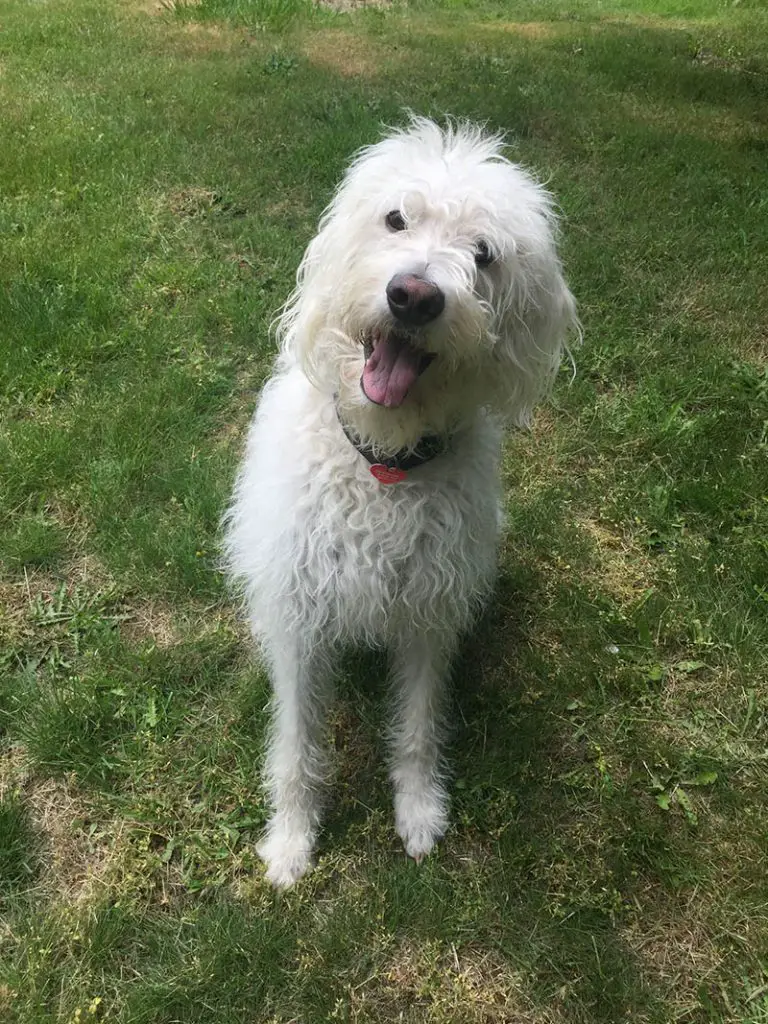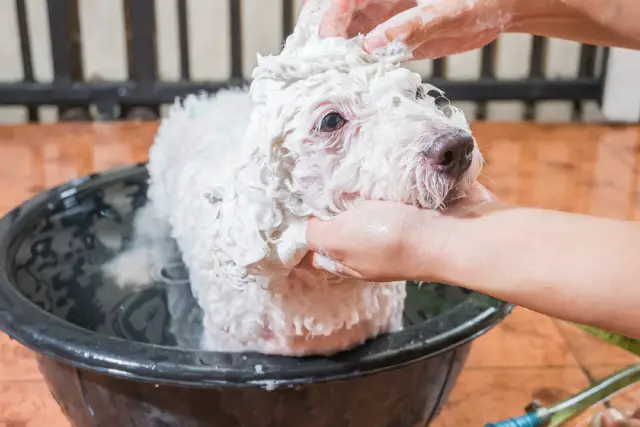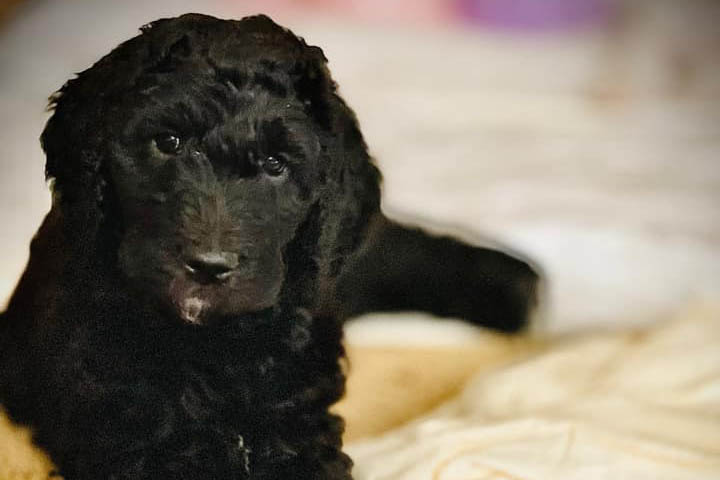If you are considering a new dog and suffer from allergies, you may question whether a Double Doodle breed is a suitable option? Are Double Doodles shedders, and do genetics influence their adult coats? Find all the answers here.
Double Doodles are considered hypoallergenic and a low shed breed. Given that Double Doodles are a hybrid breed, their coat type and the extent of shedding vary depending on their inherited genes.

Consider Double Doodle Genetics
Double Doodles are a modern hybrid dog breed comprising approximately 25% Golden Retriever, 25% Labrador Retriever, and 50% Poodle. Typically, Double Doodles are the result of breeding a Labradoodle and Goldendoodle, but the percentage of Retriever and Poodle may vary.
The Golden Retriever and Labrador Retriever have dense double coats that shed regularly. Retrievers shed lightly all year round and shed their thick undercoat in larger quantities two times a year. Conversely, Poodles are single-coated and mostly non-shedding but require regular grooming.
Most Double Doodles have more dominant Poodle genes, but this can differ due to their genetic diversity. If your Double Doodle presents with a curlier coat, they will shed very little, whereas if their coats are wavy or straighter, they will shed a bit more than the average Doodle.
A curly coat holds on to dander, dirt, and shed much better than wavy or straighter coats. Curly-haired dog breeds like the Poodle are often low-shedding but not always low maintenance.
Can Your Double Doodle Breeder Predict Shed Type?
The nature of the hybrid mixed breed can make it difficult to predict with 100% accuracy what type of shed they will end up with. A reputable breeder can make a reliable prediction of coat type when your pup is around six weeks of age.
All Double Doodle litters have a 25% chance of having puppies that shed. Though, most of a Double Doodle litter will be non-shedding.
Choosing a reputable breeder and requesting details on the pup’s parents’ ancestry can also help lower the probability of ending up with a non-curly or higher shedding Double Doodle.
Does Low Shedding Mean a Low Maintenance Dog?

Although Double Doodles are low maintenance and hypoallergenic dog breed, they still require a degree of care. You can unknowingly encourage shedding even on a low-shedding Double Doodle if you do not bathe or brush them regularly.
Double Doodle requires weekly brushing to prevent matting and build-up of dander, dirt, and oils. If your Double Doodle regularly enjoys muddy outdoor adventures, you may need to brush more frequently.
A high-quality, balanced diet is also essential for a healthy coat. A bad diet can lead to hair loss even in a low-shedding breed.
A slicker brush like this one will help maintain and remove any shedding hair. They are designed to be easy to clean and brush without hurting your pet’s delicate skin or fur. Hertzko Self-Cleaning Slicker Brush for Dogs.
Does Low Shed Mean Double Doodles are Allergy-Free?
A common misconception is that a hypoallergenic dog is safe for allergy sufferers.
Although hypoallergenic dogs are safer than non-hypoallergenic dogs, they can still affect acute allergy sufferers.
People that suffer from allergies pertaining to dogs are typically allergic to the dog’s saliva, urine, and dander. All dogs, even low shedding dogs, produce dander.
Some people suffering from severe allergies will react to even the most hypoallergenic dog breeds, such as the purebred Poodle.
A Double Doodle is suitable for mild allergy sufferers, but I will still recommend spending some time with a Double Doodle to test if any reaction occurs before bringing your furry friend home.
Related Reading: Are Cavapoos (Cavoodles) Hypoallergenic? Answered!
Reasons Your Low Shedding Double Doodle May Still Shed

You can be confident that a Double Doodle will have little or no shed, and those with more than average shed most likely are suffering from a health condition or sensitivity.
Environmental Sensitivities
If you have a dog like mine, you will be fully aware of the bothersome effects of environmental allergens on your Double Doodle.
Scratching, itching, watering eyes, flaking skin, and hot spots can result from an allergy to pollen, dust, grass, or trees. Some dogs will scratch so much that they will lose hair in areas of their bodies.
The best option, in this case, would be to take your dog to a veterinarian and see whether allergy medications or shampoos can help to ease the irritation and allergic reactions.
I found that washing my dog regularly with a shampoo such as the Veterinary Formula Clinical Care Antiparasitic & Antiseborrheic Medicated Dog Shampoo makes an enormous difference. Anti-allergy pills prescribed by your vet can also assist if the problem is more severe.
Food Sensitivities
Countless dogs are allergic to common foods found around the home and in commercial dog foods. These dogs usually suffer from persistent scratching and chronic ear infections.
Getting to the source of the problem can be time-consuming, but with a veterinarian’s help and excluding ingredients from their diet, you can get to the bottom of the problem. Some dog foods are formulated especially with allergy-suffering dogs in mind.
The scratching and biting of the fur and skin can cause shedding and uncomfortable skin infections. Adding some omega oils to my dog’s food helped with the discomfort and skin shedding.
Health Problems
Double Doodles can suffer from skin conditions that can make them itchy, their skin dry, and prone to having their hair fall out. Sebaceous adenitis is one of these uncommon immune-mediated dermatosis conditions.
Digestive issues and hypothyroidism can also lead to hair loss and balding in dogs. Specific medication side effects can also trigger hair loss in your Double Doodle.
If hair loss is believed to be associated with hypothyroidism, you can easily have your Double Doodle tested at your local veterinarian. This condition can be managed with the correct medication.
It is always best to visit your vet if your Double Doodle is itching, balding, has a foul odor, or displays a change in its usual behavior.
Frustration
Double Doodles are social, friendly dogs that thrive on attention and new challenges.
If you are out and about a lot and your dog is left for long periods on their own, they may become bored and frustrated, which can lead to chewing of the skin and fur.
Should you notice hair loss and anxiety-related behavior in your Double Doodle, you need to increase the level of exercise and mental stimulation that they are receiving. If this is not possible, you may want to consider a doggy day-care or dog walker when you are unavailable.
Too Much Bathing

Bathing your Double Doodle too frequently can also bring about additional shedding. Too much bathing can dry out your dog’s sensitive skin and can lead to increased hair loss.
When you bathe your dog too often, you strip away the natural oils from your dog’s skin, leading to irritation, scratching, dryness, and irregular hair loss.
Your Double Doodle should not be bathed more than once per week. Typically, a bath every three to six weeks is sufficient with regular grooming.
Do Double Doodle Puppies Shed?

The transition from puppy to the adult Double Doodle coat may seem to occur overnight. Their coat will change anywhere from four months up to two years of age. Typically, the transition occurs between the four and eight-month periods.
The puppy coat is soft, silky, and easy to care for, but their coats become wirier, stiffer, and thicker with their transition to adulthood.
The puppy coat sheds as the adult coat grows in. The fur does not just drop off but instead gets caught in their adult coat. Consequently, regular brushing during this transitional stage of their life is very important to reduce matting and knotting.
Brushing more carefully under their armpits, ears, backs of their legs, and base of their tails is essential as these are the areas that get matted the most.
With regular bathing, you may not even notice the puppy shedding its soft fur. Depending on your puppy’s coat type, the shedding and coat change may go unnoticed.
Related Reading:
- Double Doodle Dogs: Pros and Cons
- How to Get Your Puppy to Sleep Past 6 am: Answered!
- Do Cavapoos Shed Hair or Their Coat? (Answered by an Owner)
- What Age Can Labrador Puppies Go Up and Down Stairs?
- Danoodle Dogs: Pros and Cons | Should You Get One?
- Schnoodle Coat Types And How To Care For Them
- Bernedoodle Temperament Guide: Bernese Mountain Dog Poodle Mix
